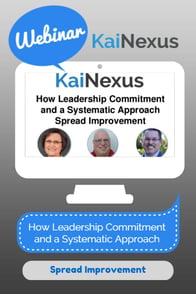 Dr. Ethan Burris, a Professor at the University of Texas McCombs School of Business, has spent many years researching employee engagement, the impact of managers on employee engagement, and idea systems.
Dr. Ethan Burris, a Professor at the University of Texas McCombs School of Business, has spent many years researching employee engagement, the impact of managers on employee engagement, and idea systems.
His research has been featured on our blog a few times in the past, and we were lucky enough to score him as a Keynote at our 2015 User Conference. We really admire his work, and needless to say, we were pretty excited when he reached out to us about his latest Harvard Business Review article entitled "Employee Suggestion Schemes Don't Have to Be An Exercise in Futility."
The article starts out strong with the statement "Here’s the irony of moving up in most organizations: You have more power to make changes but less visibility into what should change." Isn't that the problem that so many of us face in continuous improvement? We know that change must be made, and while we can set goals and lay out projects to make those changes, we can't actually identify the day-to-day improvements that must take place. For that, we need the help of the everyone in the organization.
Because you can't directly engage with everyone in your organization, it's common for leaders to rely on technology to help elicit employee suggestions for improvement. In Burris' latest article, he enumerates the reasons that this doesn't work.
- Giving people a way to share their ideas doesn't mean that they will.
- Companies focus more on collecting ideas with new technology than they do on productively evaluating and ranking them.
- Because so few improvements are implemented, electronic suggestion boxes breed an overwhelming sense of futility.
In the end of the article, Burris concludes that systems like KaiNexus that focus on capturing lots of small, incremental improvements and implementing over 75% of them do a better job of spreading an improvement culture.
That 75% is a number that we're particularly proud of. Whereas a typical suggestion system results in the implementation of a mere 1-2% of submissions, our continuous improvement platform increases engagement, accelerates improvement, and drives impact to the point where people submit their ideas because they know they'll probably be implemented.
That implementation rate is one of the biggest drivers of a culture of continuous improvement. Our customers get there because they have developed a precise set of leadership behaviors coupled with a consistent, simple, and disciplined improvement methodology.
Check out one of our top customers, Mary Greeley Medical Center, as they share how leadership commitment and a systematic approach spread improvement in this webinar!
How Leadership Commitment and A Systematic Approach Spread Improvement

- How MGMC has combined Lean tools and methodologies with a "managing for daily improvement" approach
- How leadership and technology enable and support successful improvement methodologies
- MGMC's vision for leaders getting everybody engaged in improvement
- How MGMC has systematically (and successfully) spread continuous improvement methodologies across the hospital over the past 12 months
- Why it's important to engage leaders and to educate them about improvement and the role they need to play



Add a Comment